There have been a couple of suggestions here that black and white images of rugs are sometimes actually advantageous and that this might be true of the relatively complex designs of most engsis in particular. I am going to take advantage of this suggestion to do something I have been tempted to do anyway.
Those who follow the literature on Turkmen weaving know that there is a noteworthy collection of 61 Turkmen weavings in Hungary in the Budapest Museum of Applied Arts. This collection was published by Karoly Gombos in 1975. The images are all black and white. The text is mostly in Hungarian, but there is an English language summary at the beginning.
Gombos, entitles this catalog “Old Turkmenian Rugs,” and perusal of the images suggests that this may well be the case. There are seven engsis in this collection and I have provided you with the black and white images of them below. I can tell the tribal designations and the sizes from the catalog descriptions but cannot read much of the rest of the technical descriptions at all.
An on-line Hungarian-English dictionary tells me that “cosmo” is “knot” in Hungarian but becomes more inscrutable when the knots on pieces also indicated as “Tekke” are sometimes given as “szenne” (perhaps “Senna?”) but in other instances as “jordez” (which doesn’t seem to suggest any of the English words used to indicate a “symmetric” knot) and besides which wouldn’t make much sense for a Tekke piece. Perhaps someone on the board will be able to clarify.
Here are the images of the Hungarian engsis.
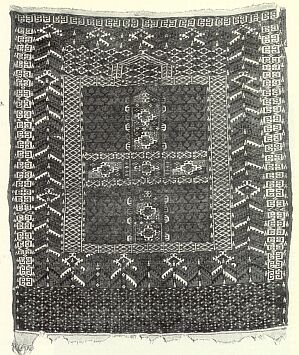
This first piece is described as Tekke and is 132 cm long and 114 cm wide. It is graphically attractive with the crossing panels decorated with small compartmented gul devices. The inner borders around this area and under the “mirhab” are composed of a series of diamond forms with hooked appendages and frames this area nicely without competing with the standard outside borders.
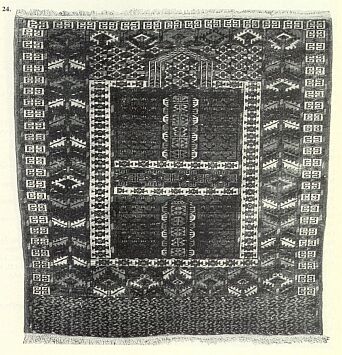
This second piece is also Tekke and is nearly square at 127 cm long and 122.5 cm wide.
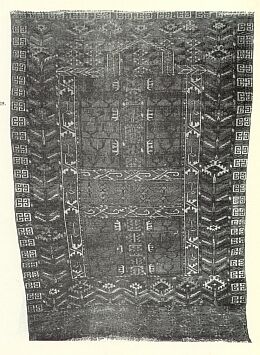
The piece above is confusingly labeled “Jomut, vagy Tekke,” with a “szenne” knot and seems pretty clearly Tekke to me. Its photograph is poor even for a black and white image. It is 156 cm long and 110 cm wide. This piece seems potentially older to me, in part because of the relatively few, large scale, “candlabra-like” devices that are staggered in alternate rows (some claim that the staggered arrangement is itself a sign of age but I’ve not seen that confirmed), and partly because of the use and rendition of the “curled leaf” in the framing and horizontal division of the “hatchli” area.
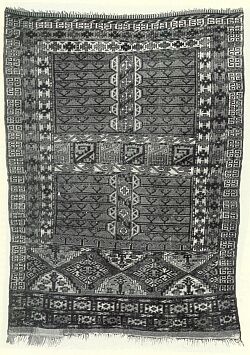
The engsi above also has a catalog label that seems indecisive: “Jomut, Vagy Csaudor.” The devices that apparently make for uncertainty are the half “ertman” guls used in the panel just above the lowest one in this piece. This device is used a lot by the Chodors, but also occurs on pieces attributed to the Yomuts and to the Ersaris. The abbreviated and compartmented curled leaf usage in central horizontal panel in the “hatchli” area, as well as the white ground borders above and below it are also unusual. The knot is described as “szenne.” This piece is 160 cm long and 105 cm wide.
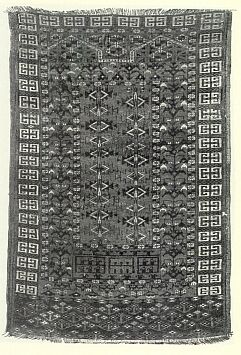
The piece above is labeled “Kizil-Ajak.” One of the claimed indicators of a Kizil Ayak attribution is fineness. Gombos gives the knot density of this piece as 990/dm2. This is much lower than any of the Kizil Ayaks that Loges presents. His coarsest one is 1500/dm2 and the rest of his Kizil Ayak pieces are 2000/dm2 or above. This difference makes me suspect this Kizil Ayak attribution. Nevertheless, this is an interesting and unusual rug. It is quite narrow at 96 cm (it’s 152 cm long), and has a two “mirhab” treatment at the top, is not a member of the “hatchli” group, and has an unusual lower cross panel with compartments that have indefinite internal devices. The knot is “szenne.”
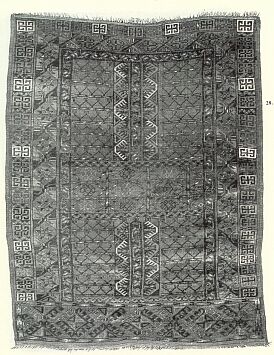
The piece above is one of the two Ersari engsis in this Hungarian collection. It is 154 cm long and 118 cm wide. It has a feature seen on some other engsis in the salon about which I have meant to ask: the “candlabra-like” devices are connected to one another. This usage occurs in other (but not all) Ersari engsis but seem always to be the case with Salor engsis. I have wondered whether this connecting treatment is significant and also if it might license a bit a suspicion of close connection between the Salors and the Ersaris.
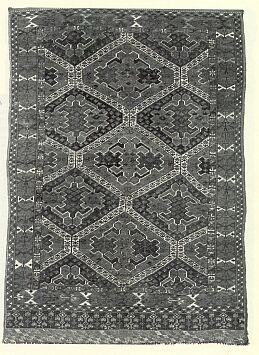
The piece above is one of those engsis that clearly and dramatically departs from the “hatchi” format and is similar in some respects to Rug 18 in the initial salon essay.
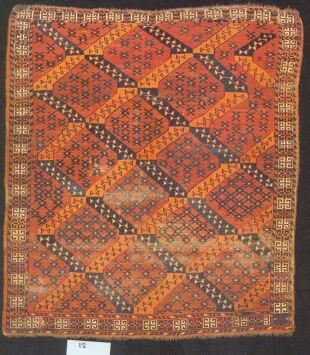
The Gombos piece is 186 cm long and 135 cm wide.
The measurements provided for these Hungarian pieces reminded me again of our discussion of Peter Andrews suggestion that door width might suggest something about which pieces are more likely to have been used as door rugs. Notice that the widths of these pieces mostly meet Peter’s suggested 120 cm maximum.
114 cm
122.5 cm
110 cm
105 cm
96 cm
118 cm
135 cm
One piece is only 2.5 cm too wide and the other is an Ersari piece that is also a dramatic design departure from the most traditional design usage.
I don’t want to make too much of this, because admittedly the widths we collected varied quite a lot and often exceeded the suggested 120 cm maximum, but we did notice that Tekke pieces that would likely be dated as older tended to meet it. The narrow widths of most of these Hungarian pieces give for me a little more credence to Gombos’ claim in his title of this catalog that these are “older” Turkmen weavings.
There is one last piece in this Hungarian collection that relates to our discussion in this salon. Gombos presents a door surround that he describes as “Jumut-Tekke.”
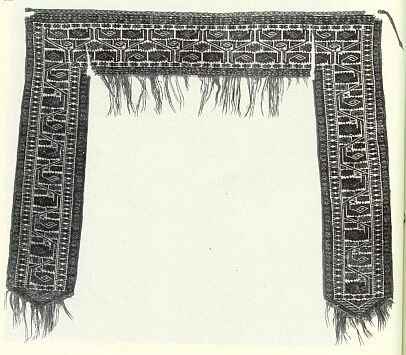
There are two interesting things to notice about this piece. First, it seems likely to have been used, since it is torn at precisely the points of greatest pressure as folks brushed against it going in and out. And there is in the measurements reason for believing that such brushing occurred. Gombos gives them as 115 X 101 cm. He has usually in this book adopted the convention of give the length of a piece first but even if he has reversed them in this case (and I think he may have) the inside width of this piece (which should approximate that of the door opening) is well under 120 cm.
Regards,
R. John Howe